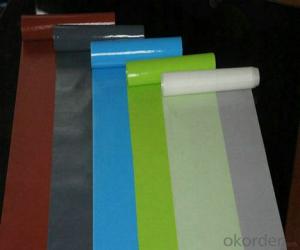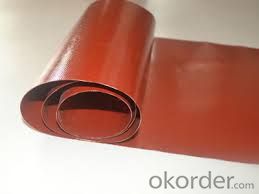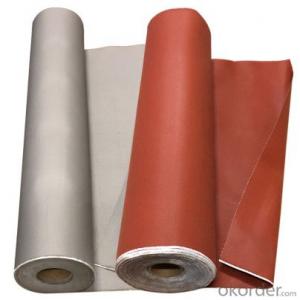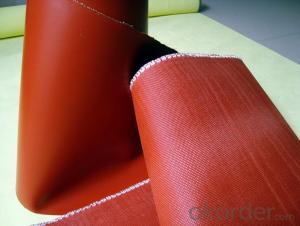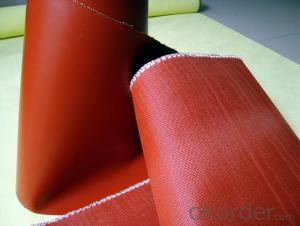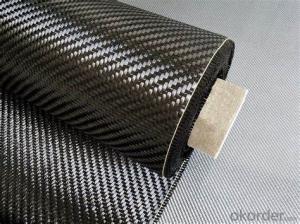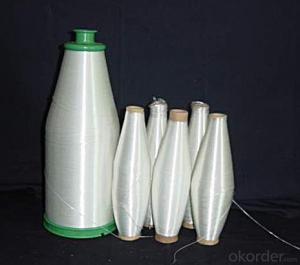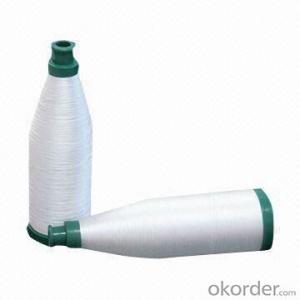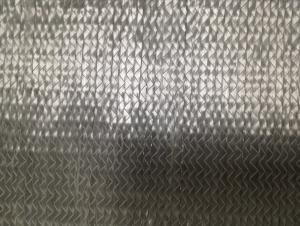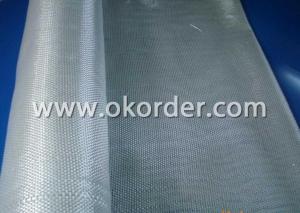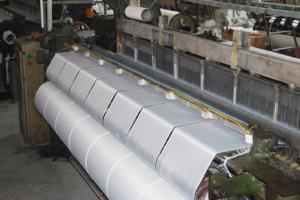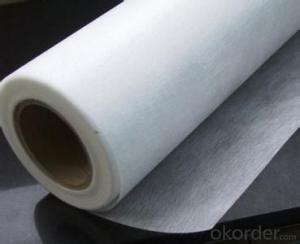Unidirectional Fiberglass Fabric Coated Silicone for Construction Use
- Loading Port:
- Shanghai
- Payment Terms:
- TT OR LC
- Min Order Qty:
- 500 m²
- Supply Capability:
- 50000 m²/month
OKorder Service Pledge
OKorder Financial Service
You Might Also Like
Silicone Coated Fiberglass Fabric for Construction Use
Fiberglass Fabric Description
Silicone coated fiberglass fabric are made of fine fiberglass with excellent capacity of high temperature and corrosion resistance, coated and rolled with silicone rubber, which is a brand new product with good performance and multiple applications.
Fiberglass Fabric Specification
Thickness:0.2mm-5mm
Width:100cm-150cm
Color;grey/red/silver/black
Weight(coating):130gsm-2800gsm
Model No | FSD2030 | FSD2030 | FSD2050 | FSD2100 | |
High temperature resistant(°C) | ≤280 | ≤280 | ≤280 | ≤280 | |
Low temperature resistant(°C) | ≥-40 | ≥-40 | ≥-40 | ≥-40 | |
Tensile intensity (N/50mm) | Warp | ≥1750 | ≥1750 | ≥2500 | ≥3500 |
Weft | ≥1280 | ≥1280 | ≥2100 | ≥3000 | |
Inflating burst intensity(Mpa) | ≥2.0 | ≥2.0 | ≥2.2 | ≥2.6 | |
Peeling intensity(N/m) | ≥450 | ≥450 | ≥520 | ≥600 | |
Insulation (kv/mm) | 16 | 16 | 18 | 18 | |
Weight (g/m*m) | 550-650 | 550-650 | 750-800 | 1500-1800 | |
Width(mm) | 1000±20 | 1000±20 | 1000±20 | 1000±20 | |
Thickness(mm) | 0.3-0.4 | 0.3-0.4 | 0.05-0.55 | 1.0-1.1 | |
color | Silver-gray, gray, red | lucency | Silver-gray, gray, red | Black, gray, red | |
Fiberglass Fabric Features:
1, Good performance on resisting high temperature and low temperature, -40°C-280°C;
2, High strength;
3, Ozone, oxide, light and weather aging resistance;
4, High insulation: dielectric constant:3-3.2, breakdown voltage: 20-50KV/MM;
5, Chemical corrosion resistant, oil-proofing, waterproofing (washable)
Fiberglass Fabric Application:
1) Electric insulation: it feature high grade of electric insulation and bear a load of high voltage. It fits for making products like insulation cloth and sleeves et.
2) Non - metalli compensator: used as pipeline oupling, non-metallic compensactor helps to avoid damage caused by heat expansion and cold contraction. This membrane material speially fit for using in industres of petroleum, chemical engineering, cement, iron and steel and good elasticity and toughness.
3)Anti-conrrosion sector: It is good to be used as inner and outer anti-corrosion layer featuring excellent corrosion resistance, tempareture resistance and high strength. It proves to be an ideal anti-corrosion material.
4) Others: Apart from above application, it can also be used as sealing material, temperature resistant and anti-orrosion conveyr belt and packaging material.
Product Show
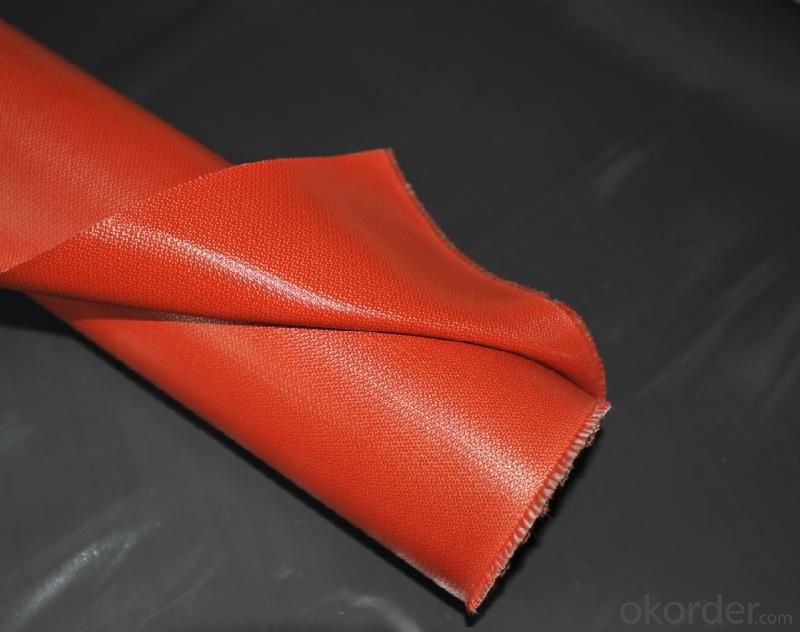

FAQ
1.What are the characteristics of fiberglass fabric?
a)Outstanding temperature resistance(from -70°C to +260°C)
b)Excellent chemical resistance
c)Superior non-stick surface, easy to clean
d)High dielectric strength
e)Dimensional stability
f)Resistance to UV, IR and HF
g)Non-toxic
2.How many methods to weave the fabric?
Four methods to weave the fabric:
a).Plain weave: it can be used in electricity insulation materials and reinforced materials in industry, because of inseparable structure, plain and clear lines.
b).Twill weave: compared with plain weave, it is of high density, high intensity, with a soft and loose structural weave. It can be used in ordinary reinforced materials, filter materials, and painting cloth.
3.Can you offer us some samples?
We are willing to offer our customers best product&service,if it's necessary we can send
you sample for test;also we welcome all you customer have a trial order.
- Q: What are the different colors available for fiberglass fabric?
- Fiberglass fabric is available in a wide range of colors to suit different preferences and applications. The most common colors include white, black, gray, and beige. These neutral colors are often used in industrial and commercial settings where aesthetics may not be a priority. However, fiberglass fabric is also available in vibrant colors such as red, blue, green, and yellow, which are commonly used in architectural and design applications. Additionally, custom colors can be created by dyeing the fabric to meet specific requirements. The availability of different colors allows for flexibility in design and ensures that fiberglass fabric can be seamlessly integrated into various projects.
- Q: Can fiberglass fabric be used for making insulation tape?
- Yes, fiberglass fabric can be used for making insulation tape. Fiberglass fabric is known for its excellent thermal insulation properties, as it is made from woven glass fibers that are resistant to high temperatures. These fabric tapes are commonly used in various industries, such as electrical, automotive, and aerospace, for insulating and protecting wires, cables, and pipes from heat and electrical currents. The fiberglass fabric is typically coated with a heat-resistant adhesive, which allows it to adhere to various surfaces and provide a secure insulation barrier. Overall, fiberglass fabric is a suitable choice for making insulation tape due to its thermal resistance, durability, and versatility.
- Q: Is fiberglass fabric resistant to pests and insects?
- Yes, fiberglass fabric is generally resistant to pests and insects due to its synthetic composition and smooth surface, which makes it an unfavorable environment for them to thrive and cause damage.
- Q: Can fiberglass fabric be used for gaskets and seals?
- Certainly, gaskets and seals can be made using fiberglass fabric. Renowned for its ability to withstand high temperatures, durability, and exceptional insulation properties, fiberglass fabric is an ideal material for manufacturing gaskets and seals across a range of industries such as automotive, aerospace, industrial, and marine. By utilizing this fabric, one can fashion customized gaskets and seals that possess a snug and secure fit, effectively averting any fluid or gas leakage. Moreover, fiberglass fabric exhibits remarkable resilience when confronted with harsh chemical conditions, rendering it a dependable option for gaskets and seals that must endure exposure to corrosive substances.
- Q: Can fiberglass fabric be used for making conveyor belts?
- Yes, fiberglass fabric can be used for making conveyor belts. It is a durable and lightweight material that offers high tensile strength and excellent resistance to abrasion and chemicals, making it suitable for conveyor belt applications in various industries.
- Q: Can fiberglass fabric be used for reinforcement in septic tanks?
- Yes, fiberglass fabric can be used for reinforcement in septic tanks. Fiberglass fabric is known for its strength and durability, making it an excellent choice for reinforcing structures, including septic tanks. The fabric can be used to reinforce the walls and base of the tank, providing additional strength and preventing cracks or leaks. Additionally, fiberglass fabric is resistant to corrosion, which is important in a septic tank environment where there can be high levels of sewage and chemicals. Overall, using fiberglass fabric for reinforcement in septic tanks can enhance their longevity and structural integrity.
- Q: How does fiberglass fabric handle abrasion in mining operations?
- Due to its outstanding durability and resistance to wear and tear, fiberglass fabric is a superior option for managing abrasion in mining operations. In the harsh conditions commonly found in mining, where abrasive materials like rocks, stones, and minerals are frequently encountered, fiberglass fabric withstands the test. The high tensile strength of fiberglass fabric is one of its key properties, allowing it to endure constant rubbing and scraping against abrasive surfaces. The tightly woven structure of the fabric acts as a protective shield, preventing abrasive particles from penetrating and causing damage. Furthermore, fiberglass fabric exhibits remarkable resistance to chemical corrosion, a common occurrence in mining environments. It can endure exposure to acids, alkalis, and other corrosive substances commonly found in mining operations. This resistance guarantees that the fabric remains intact and functional even in the presence of harsh chemicals, thus enhancing its durability against abrasion. Moreover, fiberglass fabric possesses excellent heat resistance, making it suitable for mining operations involving high temperatures. It can withstand extreme heat conditions without compromising its structural integrity or performance. This characteristic is particularly essential in operations such as smelting, which involve intense heat. Additionally, fiberglass fabric is lightweight and flexible, making it easy to handle and install in mining equipment. Its flexibility allows it to conform to irregular shapes and surfaces, ensuring a secure fit and maximum protection against abrasion. To summarize, fiberglass fabric is an ideal choice for handling abrasion in mining operations due to its exceptional durability, resistance to wear and tear, chemical corrosion resistance, and heat resistance. Its high tensile strength, flexibility, and lightweight nature make it a reliable and practical solution for safeguarding mining equipment and machinery from the abrasive forces encountered in these operations.
- Q: How does fiberglass fabric perform in chemical exposure?
- Fiberglass fabric performs exceptionally well in chemical exposure. Due to its inherent resistance to a wide range of chemicals, it is commonly used in various industries where exposure to corrosive substances is expected. The fabric's composition, typically consisting of glass fibers woven together, provides a strong barrier against chemical attack and degradation. In many cases, fiberglass fabric can withstand exposure to acids, alkalis, solvents, and other corrosive chemicals without experiencing any significant damage or deterioration. This resistance to chemical attack makes it an ideal choice for applications such as chemical storage tanks, pipes, ducts, and equipment linings. Moreover, the fabric's non-reactive nature helps prevent contamination or leaching of chemicals into the surrounding environment, making it a safe and reliable option for handling hazardous substances. Additionally, fiberglass fabric's thermal insulation properties can further enhance its performance in chemical exposure by offering protection against extreme temperatures that may accompany certain chemical processes. However, it is important to note that the specific performance of fiberglass fabric in chemical exposure can vary depending on the type and concentration of the chemical, as well as the duration and temperature of exposure. Therefore, it is always recommended to consult with manufacturers or industry experts to ensure the suitability of fiberglass fabric for a particular application and to determine any necessary precautions or compatibility considerations.
- Q: Is fiberglass fabric suitable for making outdoor furniture covers?
- Indeed, fiberglass fabric proves to be an ideal material for crafting covers for outdoor furniture. Renowned for its robustness and ability to withstand harsh weather, it becomes an exceptional choice for shielding outdoor furniture against rain, sunlight, and wind. Its resistance to water and UV rays, coupled with its capacity to endure extreme temperatures without deterioration or fading, further enhance its suitability. Furthermore, fiberglass fabric's lightweight nature simplifies handling and installation on furniture. It also fends off mold, mildew, and pests, ensuring the cleanliness and protection of your furniture. All in all, fiberglass fabric emerges as a dependable and enduring option for fashioning outdoor furniture covers.
- Q: Can fiberglass fabric be used for insulation in underground structures?
- Yes, fiberglass fabric can be used for insulation in underground structures. Fiberglass fabric is a popular choice for insulation due to its excellent thermal properties and resistance to moisture. It is commonly used in various applications, including underground structures such as basements, tunnels, and underground storage facilities. The fabric is typically installed as a layer between the structure's walls or ceiling and its interior finish, providing a barrier that helps to prevent heat loss or gain and maintain a comfortable temperature inside the structure. Additionally, fiberglass fabric is lightweight, flexible, and easy to install, making it a convenient option for insulating underground spaces.
Send your message to us
Unidirectional Fiberglass Fabric Coated Silicone for Construction Use
- Loading Port:
- Shanghai
- Payment Terms:
- TT OR LC
- Min Order Qty:
- 500 m²
- Supply Capability:
- 50000 m²/month
OKorder Service Pledge
OKorder Financial Service
Similar products
Hot products
Hot Searches
Related keywords
